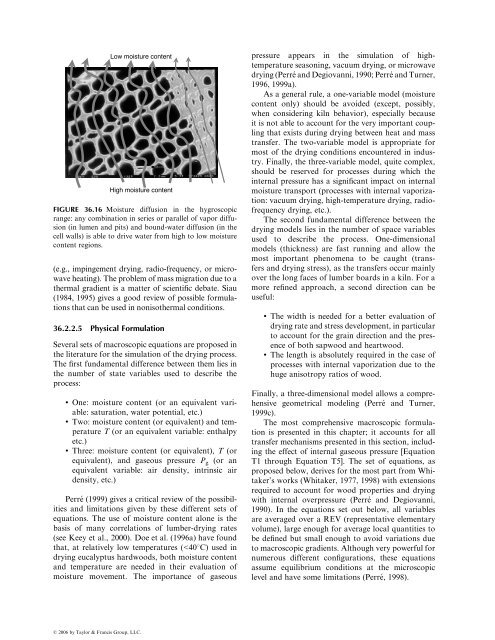36 Drying of Wood
36 Drying of Wood
36 Drying of Wood
- No tags were found...
Create successful ePaper yourself
Turn your PDF publications into a flip-book with our unique Google optimized e-Paper software.
Low moisture contentHigh moisture contentFIGURE <strong>36</strong>.16 Moisture diffusion in the hygroscopicrange: any combination in series or parallel <strong>of</strong> vapor diffusion(in lumen and pits) and bound-water diffusion (in thecell walls) is able to drive water from high to low moisturecontent regions.(e.g., impingement drying, radio-frequency, or microwaveheating). The problem <strong>of</strong> mass migration due to athermal gradient is a matter <strong>of</strong> scientific debate. Siau(1984, 1995) gives a good review <strong>of</strong> possible formulationsthat can be used in nonisothermal conditions.<strong>36</strong>.2.2.5 Physical FormulationSeveral sets <strong>of</strong> macroscopic equations are proposed inthe literature for the simulation <strong>of</strong> the drying process.The first fundamental difference between them lies inthe number <strong>of</strong> state variables used to describe theprocess:. One: moisture content (or an equivalent variable:saturation, water potential, etc.). Two: moisture content (or equivalent) and temperatureT (or an equivalent variable: enthalpyetc.). Three: moisture content (or equivalent), T (orequivalent), and gaseous pressure P g (or anequivalent variable: air density, intrinsic airdensity, etc.)Perré (1999) gives a critical review <strong>of</strong> the possibilitiesand limitations given by these different sets <strong>of</strong>equations. The use <strong>of</strong> moisture content alone is thebasis <strong>of</strong> many correlations <strong>of</strong> lumber-drying rates(see Keey et al., 2000). Doe et al. (1996a) have foundthat, at relatively low temperatures (
















